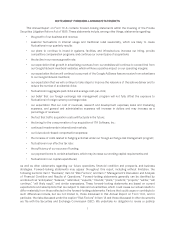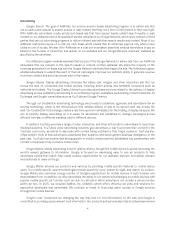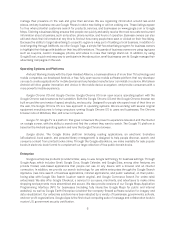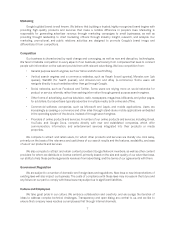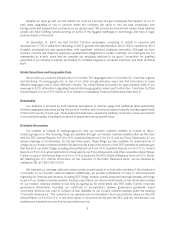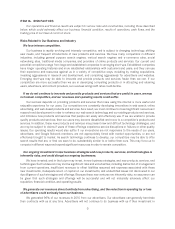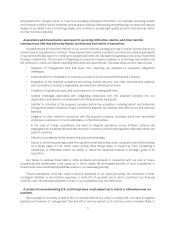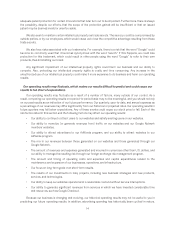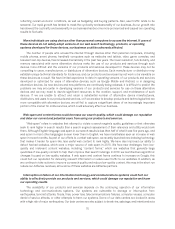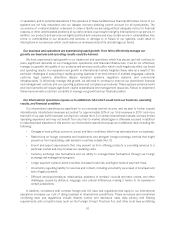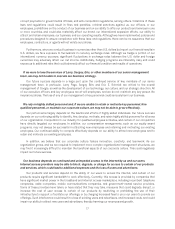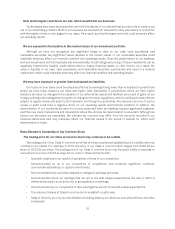Google 2010 Annual Report Download - page 22
Download and view the complete annual report
Please find page 22 of the 2010 Google annual report below. You can navigate through the pages in the report by either clicking on the pages listed below, or by using the keyword search tool below to find specific information within the annual report.ITEM 1A. RISK FACTORS
Our operations and financial results are subject to various risks and uncertainties, including those described
below, which could adversely affect our business, financial condition, results of operations, cash flows, and the
trading price of our Class A common stock.
Risks Related to Our Business and Industry
We face intense competition.
Our business is rapidly evolving and intensely competitive, and is subject to changing technology, shifting
user needs, and frequent introductions of new products and services. We have many competitors in different
industries, including general purpose search engines, vertical search engines and e-commerce sites, social
networking sites, traditional media companies, and providers of online products and services. Our current and
potential competitors range from large and established companies to emerging start-ups. Established companies
have longer operating histories and more established relationships with customers and users, and they can use
their experience and resources against us in a variety of competitive ways, including by making acquisitions,
investing aggressively in research and development, and competing aggressively for advertisers and websites.
Emerging start-ups may be able to innovate and provide products and services faster than we can. If our
competitors are more successful than we are in developing compelling products or in attracting and retaining
users, advertisers, and content providers, our revenues and growth rates could decline.
If we do not continue to innovate and provide products and services that are useful to users, we may
not remain competitive, and our revenues and operating results could suffer.
Our success depends on providing products and services that make using the internet a more useful and
enjoyable experience for our users. Our competitors are constantly developing innovations in web search, online
advertising, and web-based products and services. As a result, we must continue to invest significant resources in
research and development in order to enhance our web search technology and our existing products and services,
and introduce new products and services that people can easily and effectively use. If we are unable to provide
quality products and services, then our users may become dissatisfied and move to a competitor’s products and
services. In addition, these new products and services may present new and difficult technology challenges, and
we may be subject to claims if users of these offerings experience service disruptions or failures or other quality
issues. Our operating results would also suffer if our innovations are not responsive to the needs of our users,
advertisers, and Google Network members, are not appropriately timed with market opportunities, or are not
effectively brought to market. As search technology continues to develop, our competitors may be able to offer
search results that are, or that are seen to be, substantially similar to or better than ours. This may force us to
compete in different ways and expend significant resources in order to remain competitive.
Our ongoing investment in new business strategies and new products, services, and technologies is
inherently risky, and could disrupt our ongoing businesses.
We have invested, and in the future may invest, in new business strategies, and new products, services, and
technologies. Such endeavors may involve significant risks and uncertainties, including distraction of management
from current operations, insufficient revenues to offset liabilities assumed and expenses associated with these
new investments, inadequate return of capital on our investments, and unidentified issues not discovered in our
due diligence of such strategies and offerings. Because these new ventures are inherently risky, no assurance can
be given that such strategies and offerings will be successful and will not materially adversely affect our
reputation, financial condition, and operating results.
We generate our revenues almost entirely from advertising, and the reduction in spending by or loss
of advertisers could seriously harm our business.
We generated 96% of our revenues in 2010 from our advertisers. Our advertisers can generally terminate
their contracts with us at any time. Advertisers will not continue to do business with us if their investment in
9




